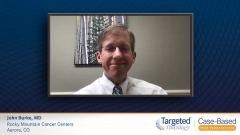
Clinical Pearls for Managing R/R DLBCL
John Burke, MD, provides clinical pearls in the recognition in treatment of relapsed/refractory diffuse large B-cell lymphoma (R/R DLBCL).
John Burke, MD: I think, because of the complexity of this disease and that it is not super common, that my practical advice for a community oncologist managing this disease would be to remember, when you have patients who experience a relapse, to have early discussion with your stem cell transplanters and your CAR [chimeric antigen receptor] T-cell therapy providers. Getting patients referred early for those modalities is important because this disease can progress quickly. There are logistical barriers to overcome to administer to patientsCAR T-cell therapy. The earlier you can get that process going, the more likely it is that your patients will be successful at receiving those potentially lifesaving therapies.
I think it is important for all of us to familiarize ourselves with these new drugs, particularly the polatuzumab vedotin-BR-tafa-len [bendamustine, rituximab, tafasitamab and lenalidomide] combination and Selinexor, so that we have the ability to prescribe them safely and effectively to our patients who need them. I encourage folks to move quickly because it is possible that, by treating patients quickly and soon in their relapse, we can sequence these drugs and these combinations one after the other so that we have the potential to turn DLBCL [diffuse large B-cell lymphoma] into a chronic disease rather than a rapidly progressive, fatal one, as it has been for so long. Making sure that our patients have the opportunity to receive all of these agents in a timely fashion is going to be important for extending their lifespans and controlling this disease for as long as possible.
Transcript edited for clarity.
Case: A 76-Year-Old Man with R/R DLBCL
Initial presentation
- A 76-year-old man presented with fatigue, loss of appetite
- PMH: atrial fibrillation, hypertension, medically controlled
- PE: palpable 5 cm right inguinal mass; bilateral axillary lymphadenopathy; splenomegaly
- ECOG PS 2
Clinical Workup
- Labs: Hb 9.9 g/dL; all others WNL
- Hepatitis B, C and HIV negative
- Excisional biopsy of the lymph node confirmed DLBCL, GCB subtype
- IHC positive for CD20
- FISH panel: t(14;18) with a BCL2 rearrangement
- Flow cytometry: CD19-postitive
- Whole body PET/CT scan showed diffuse lymphadenopathy , splenomegaly
- Ann Arbor stage III DLBCL
- IPI score intermediate-risk
Treatment
- Treated with R-CHOP x 6 cycles
- First post-treatment PET/CT scan was unremarkable; CR
- 1 year later he presents with recurrent axillary lymphadenopathy
- Repeat biopsy confirms relapse of DLBCL, GCB subtype
- He was ineligible for high-dose chemotherapy and ASCT
- Initiated tafasitamab + lenalidomide







































